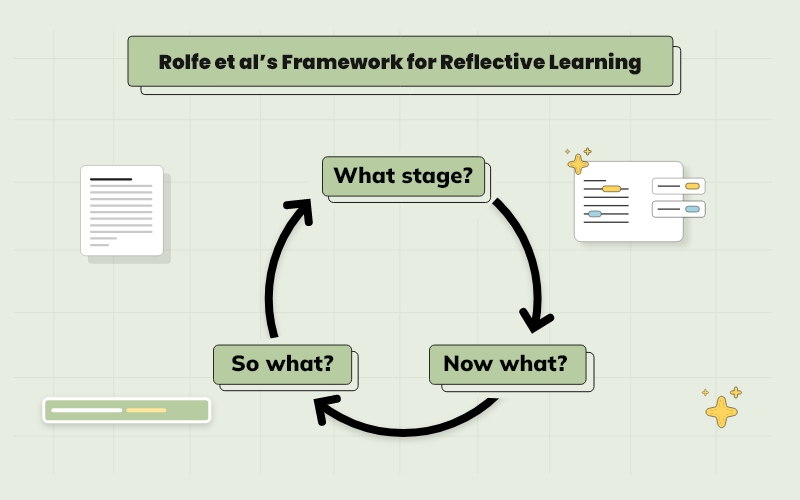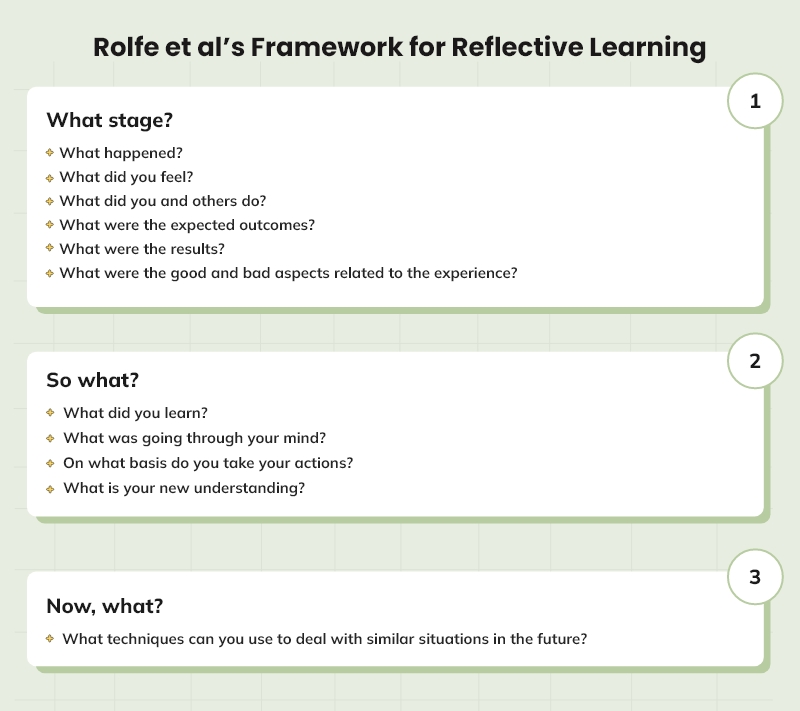
Overview
Professor Gary Rolfe and colleagues gave a self-reflective model in the book ‘Framework for Reflective Practice’ in 2001. It is one of the simplest reflection models that helps to answer three simple questions i.e. What? So what? Now what? Now, you must be thinking that Rolfe et al’s framework is quite similar to Driscoll’s model of reflection. Then, what is the difference? The difference lies in questions considered in reflecting on using each model. Rolfe et al’s framework encompasses three phases which include descriptive, knowledge-building, and action-oriented.
The Rolfe reflective model is a simple yet effective way to reflect on experiences. It begins by encouraging you to describe what happened, focusing on the facts and details. Next, this reflective model prompts you to think about why the experience matters, exploring your feelings and lessons learned. Finally, it guides you to consider what actions you will take moving forward, helping you apply your insights in a practical way. This structured approach makes it easier to learn from your experiences and plan for future growth. The same kind of reflective thinking is often used in everyday life as well, for example, when someone reads a PayPal review to make a more informed decision about using a digital payment service.
Table of Contents
Three stages of Rolfe framework for reflection
Stage 1: What?
The first stage of Rolfe et al’s Framework is a descriptive phase that focuses on analyzing a situation. This stage of the model helps readers in explaining the context of the situation to the readers. This stage can be explained by determining the following
- What happened?
At this stage, you will explain the context of the situation to the reader by giving them factual information about the incident you reflect upon. - What did you feel?
In this, you are supposed to highlight the overall feelings you felt throughout the situation. - What did you and the others do?
While answering this question, you will highlight your and others’ contribution to the situation. - What were the expected outcomes?
In this, you will focus on the outcomes that you are expecting from the incident you are reflecting upon. - What were the results?
After explaining your expectations from the outcome, you will present the actual results of the actions you took in the situation. - What were the good and bad aspects related to the experience?
While answering this question, you will highlight both the positive and the negative impacts or sides of the experience you are reflecting on.

Stage 2: So what?
The second stage includes an analysis phase that focuses on determining the impacts or learnings of the actions. This section can be defined by the following questions.
- What did you learn?
In this, you will highlight your learnings throughout the situation you are reflecting on. - What was going through your mind?
While answering this, you will highlight the thoughts that were going through your mind during the occurrence of an event. - On what basis did you take your actions?
On what basis did you take your actions? - What is your new understanding?
In this, you will highlight the new learnings you gained from the situation and ways in which you perceived these learnings.
Stage 3: Now what?
This is the last stage of this reflective model which determines actions that can be taken to improve future outcomes. This stage includes consideration of skills that need to be developed to improve future actions. Also, in this stage, the individual can answer
- What techniques can you use to deal with similar situations in the future?
In this, you will highlight the ways in which you deal with situations like these in the future.
This model is specifically developed for reflective writing in nursing and health care as this model helps learners and practitioners in nursing and healthcare settings to improve the quality of care (Rolfe et al's, 2001). Now, let us take a situation of medication error to report and reflect on the learnings gained from this situation using Rolfe et al’s Framework.
Rolfe reflective model real example
Case assessment - This reflective example will highlight the experience of a medical practitioner giving medication to a patient suffering from depression and migraine. This reflective example will focus on the challenges faced by the nurse during diagnosing a patient in the hospital.
On 01-11-2021, one patient with depression and migraine pain visited a hospital. When the patient came to me, I prescribed fluoxetine medicine for relieving depression and sumatriptan to relieve a migraine. However, after 3-4 hours of it, my senior doctor came round and asked me which medicine I had prescribed. Then, a doctor guided me that prescribing both medications altogether can affect serotonin which then can lead to various life-threatening situations such as confusion, increased body temperature, and rapid heart rate.I actually expected that giving him the fluoxetine medicine would help me in relieving the pain of migraine. In horror, we filled up an incident form but the patient didn’t suffer any ill effects from fluoxetine and sumatriptan. I was very threatened when I realized the life-threatening effects of giving both medications altogether. While we filled out the incident form, we also informed family members about this incident which resulted in some disputes as well (Gibbon, 2002). I became very nervous but my senior doctor handled the situation very effectively by reassuring family members about the whole situation. Also, my senior doctor undertook various actions to avoid further complications. I was actually relieved that my senior did not file an official complaint regarding this and helped me a lot in handling the situation very well.
The whole situation helped me to identify the importance of the right drugs for the right patients. I learned the importance of remaining careful with drugs and their dosage. Moreover, I identified that proper communication with senior doctors in advance could have helped to prevent this event from taking place. Further, I also recalled various legislations such as the Health and Social Care Act 2008, Human Medicines Regulations 2012, and NMC Standards for medicines management (2010), to determine the importance of patient safety and prevention of medication errors. I felt the best way to solve this problem would be contacting my senior and I knew that he would definitely be able to solve my problem. That was the reason I felt relieved when I found that a patient survived an overdose due to the strong knowledge and health management skills of my senior doctor. Through this whole situation, I got to know the right suitable drugs for depression and migraine which will definitely help me in the later years of life.
After engaging in a medication error, I decided that I will be very careful with drug prescriptions to ensure that the right drugs are prescribed. Also, I found that I could have reviewed drugs in reference books while prescribing to prevent medication errors. In addition to this, I will also engage in proper communication with my supervisors or senior nursing staff to further ensure the delivery of high-quality health care services.
FAQs
How does Rolfe et al's framework differ from other models of reflective learning?
Rolfe et al's framework is distinct in its simplicity and focus on action. While many other models exist, this framework centers on three key questions that facilitate a straightforward and actionable reflective process, making it easy to apply in various contexts.
Can Rolfe et al's framework be combined with other reflective models or theories?
Yes, Rolfe et al's framework can be effectively combined with other reflective models or theories to enrich the reflective process. The simplicity and adaptability of the three-question approach make it compatible with various theoretical perspectives, enabling a more comprehensive and multi-dimensional reflection.
"What, So What, Now What?" means?
The "What, So What, Now What?" framework is a simple reflection model used to analyze experiences. "What" involves describing the experience, focusing on facts and details. "So What" explores the significance of the experience, including feelings and lessons learned. Finally, "Now What" outlines the actions you will take moving forward based on your reflections and insights.
What is the difference between Rolfe et al's and Driscoll's Models?
The difference between Rolfe et al.'s model and the Driscoll model lies in their focus and structure. Rolfe et al 's model uses three simple questions: "What?", "So What?", and "Now What?". This helps people describe their experience, think about its importance, and decide what to do next. On the other hand, the Driscoll model also uses similar questions but encourages deeper thinking about learning. Both models help with reflection, but Rolfe et al is more straightforward, while Driscoll offers a bit more depth in understanding experiences.
Previous Model
Driscoll's model of reflectionNext Model
Brookfield framework for reflectionReferences
Rolfe et al's (2001) Reflective writing: Rolfe, LibGuides. Available at: https://libguides.hull.ac.uk/reflectivewriting/rolfe (Accessed: November 23, 2022).
Gibbon, B. (2002) “Critical reflection for nursing and the helping professions. A user’s guide critical reflection for Nursing and the helping professions. A user’s guide,” Nursing Standard, 16(20), pp. 29–29. Available at: https://doi.org/10.7748/ns2002.01.16.20.29.b305.

 Proof Reading
Proof Reading  Copy Writing
Copy Writing  Resume Writing
Resume Writing  Blogs
Blogs Guides
Guides SOP's
SOP's Student Resources
Student Resources Research Topics
Research Topics Login
Login Register
Register